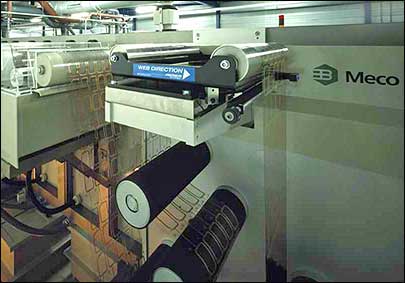Plating-equipment specialist Meco says it has developed a way to cut the cost of producing RFID antennas, and therefore RFID tags, that combines printing with plating.
The company says that by using a coating of expensive conductive ink that is thinner than that used for printed antennas, and then plating that coating with cheaper copper, it can produce antennas that are far cheaper than those made using either etched copper or aluminum, or printed conductive ink.
“We estimate that a copper etched antenna costs around €8 to €10 per square meter of raw material, whereas printing and plating will be in the range of €6 per meter,” says Jeroen van Nunen, product manager at Meco, which is based in Drunen, Netherlands. According to Meco, etching uses more-expensive copper-clad material usually 18 microns thick, which costs around €5 to €6 per square meter. Applying a resistance layer and etching away unneeded the material drives the cost up to around €8 to €10 per square meter.
Van Nunen says that high-frequency (HF) antennas made using its new method will cost 60 percent to 75 percent less than etched copper antennas. That savings applies to a HF inlay, but for a UHF inlay, the savings could be even greater, he says. An HF antenna requires approximately 12 micron of copper, but a UHF antenna requires just 3 microns of copper. Van Nunen says his company’s plating system can handle both types of antennas, but it can produce thinner antennas four times faster, resulting in much higher output and much lower cost per antenna.
Drawing on its experience in the plating industry, Meco’s has developed its Meco Flex Antenna Plating (FAP) machine, which can produce antennas using Meco’s printing and plating method. Meco designed the machine in collaboration with one of its existing customers that uses etching to produce antennas for smart cards.
The machine takes substrate (a material used as a backing film for RFID inlays) with antenna seed layers already printed on them. The difference between printing and plating is in the amount of conductive silver ink required. The electroplating process requires only an ink resistance of 150 milliohms per square meter, which means that an ink layer only 1 to 5 microns thick is needed, depending on printer system.
“Printed antennas can require between 25 to 35 microns of silver ink. That’s very high compared with the seed layer required with plating,” says van Nunen.
In addition, because the conductive ink is used only as a seed layer for the copper plating, the ink can have a relatively high electrical resistance, usually the result of a lower percentage of silver in the ink. There are a number of silver inks on the market with a resistance of 12, 20, 30 or 40 milliohms per square meter. Meco says it can work with inks that have a much higher level of resistance, up to 150 milliohm per square meter.
“Silver is quite expensive and therefore it will be a big cost factor in the conductive ink,” van Nunen explains. “So, when we can use less ink, the cost price will drop.”
In addition to reducing the requirement for expensive conductive inks, Meco’s plating process also provides savings, compared with etching antenna manufacturing, by reducing material waste. Meco says its system can produce antennas for only a few cents each based on a production volume of 7.5 million antennas per month. Meco says that while etched antennas cost around 0.05 euros each to make, antennas produced using its system would cost less than 0.015 euros each (70 percent cheaper) to manufacture.
The Meco FAP system does not print the antenna seed layers, but that job, Meco says, could be carried out by a local print shop using a range of processes, including silk-screen, gravure, inkjet and flexo. Following the plating process, the final RFID tag can be made by attaching the antenna to the chip and laminating the inlays to create finished labels.
Set for sale later in the year, the MECO FAP will be priced between 1 and 2 million euros, and will take up to four months to deliver.
Other companies that have also developed a system for plating RFID antennas include QinetiQ (see ‘Growing’ Low-Cost RFID Antennas.


